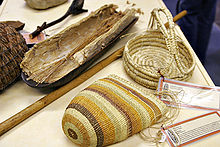Coolamon
A Coolamon is a traditional Aboriginal transport container for carrying. It serves several purposes, such as serving as a bowl with its curved sides. A Coolamon reaches a length of 30–70 cm and is shaped like a canoe.
use
Coolamons are traditionally used by Aboriginal women to store water, fruits and nuts, but also as a baby carrier. Today, when women deal with bush food , they usually use a tin can or tin can for flour. The Coolamon was worn on the head when traveling at a distance, or it was worn under the arm when used for transportation. If the Coolamon was placed on the head, a round cushion (an acartne in the language of the Arrernte ) came in between, which consisted of either a possum fur or a wreath of human hair and / or of twisted grass or feathers. This helped cushion painful head shocks and protected the cargo in the Coolamon. For the same purpose, women in India and Africa also use such pads when they carry containers on their heads. The Pintupi in the Western Desert protected themselves with a double-braided band ( ngalyibi ) made of hair or bast fibers to carry the Coolamon on their shoulders. They also wore a smaller Coolamon hat with a string around their chin.
Coolamons were also used to remove the shell of the seeds in the production process of bush bread , as well as generally as a container for cooked and baked goods. It also served as an umbrella.
Manufacturing

Coolamons were basically made by men. It was commonly sculpted from hardwood trees such as the mallee . In Central Australia , the bean tree (Erythrina vespertilio) was often used for this. A piece of the outer bark of the tree is removed and shaped over fire until it takes on the typical shape of the Coolamon. Deep ridges were cut using a flint knife . It takes a few days of work for the Coolamon to take shape. It may also have been made from tree branches or tree growths.
Coolamons were often ornamented on their outside with various carvings, such as the typical insignia of the Aboriginal tribes or with a totem design. They were also used in ceremonies, for example for aromatic smoke that was believed to have a purifying effect. The coolamons were commonly rubbed with emus fat to keep the wood in good condition.
etymology
Coolamon a word from the east coast of Australia, which comes from Murri - or the Aborigines living in Queensland , as well as from the Dharug - or Eora - Aborigines in the Sydney area . Some other names for Coolamon are:
| word | language |
|---|---|
| piti |
|
|
Ualarai |
| binguie | Wollaroi |
|
Kutthung |
| oorlarda | Bardi |
| tarnuk | |
| urtne | Arrernte |
| yandandakko | Pintupi |
| yoko | Kaurna |
Web links
- Painted Coolamon from 1942
- Picture from the British Museum
- Aboriginal: Economy & Society
- Arrernte Dictionary
- Artwork depicting a woman wearing a coolamon
Individual evidence
- ↑ Illustration of a cushion made of feathers ( Memento of the original from August 25, 2006 in the Internet Archive ) Info: The archive link was inserted automatically and has not yet been checked. Please check the original and archive link according to the instructions and then remove this notice.
- Jump up ↑ Donald Thomson, Bindibu Country , Thomas Nelson, p. 101, Melbourne 1975, ISBN 0-17-005049-1 .
- ↑ Thomson: Bindibu Country . Illustration 13

